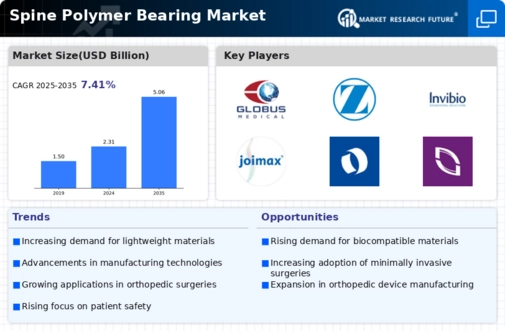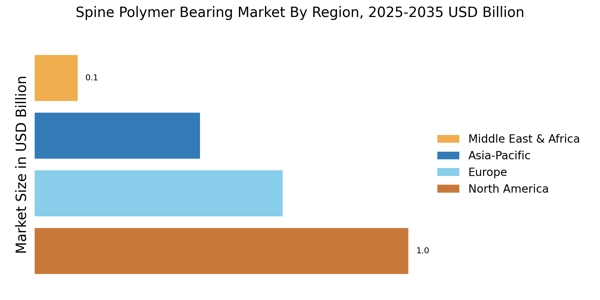Increasing Prevalence of Spine Disorders
The Spine Polymer Bearing Market is experiencing growth due to the rising incidence of spine-related disorders, such as degenerative disc disease and spinal stenosis. As populations age, the demand for effective treatment options increases. According to recent data, spine disorders affect a significant portion of the population, leading to a surge in surgical interventions. This trend drives the need for advanced materials, such as polymer bearings, which offer enhanced performance and longevity. The increasing number of spinal surgeries necessitates the development of innovative solutions, positioning the Spine Polymer Bearing Market favorably for expansion. Furthermore, the integration of polymer bearings in surgical procedures is likely to improve patient outcomes, thereby further stimulating market growth.
Technological Innovations in Bearing Design
Technological advancements play a crucial role in the Spine Polymer Bearing Market. Innovations in bearing design, including the development of advanced polymers and composite materials, enhance the performance and durability of spinal implants. These innovations are driven by the need for lighter, stronger, and more biocompatible materials that can withstand the mechanical stresses encountered in spinal applications. Recent studies indicate that the introduction of new manufacturing techniques, such as 3D printing, allows for the customization of polymer bearings, catering to specific patient needs. This adaptability is likely to attract more healthcare providers to adopt polymer bearings in spinal surgeries, thereby propelling the Spine Polymer Bearing Market forward. As technology continues to evolve, the potential for improved patient outcomes and reduced recovery times may further solidify the market's position.
Rising Investment in Healthcare Infrastructure
Investment in healthcare infrastructure is a significant driver for the Spine Polymer Bearing Market. As countries enhance their healthcare systems, there is a corresponding increase in the availability of advanced medical technologies and surgical facilities. This investment often translates into the procurement of state-of-the-art surgical equipment, including polymer bearings for spinal surgeries. Recent reports indicate that healthcare spending is on the rise, particularly in regions focusing on improving surgical outcomes and patient care. The expansion of hospitals and surgical centers is likely to create a higher demand for innovative solutions in spinal surgery, thereby benefiting the Spine Polymer Bearing Market. As healthcare infrastructure continues to develop, the market for polymer bearings is expected to flourish, driven by the need for effective and reliable surgical solutions.
Regulatory Support for Advanced Medical Devices
Regulatory frameworks are increasingly supportive of the development and approval of advanced medical devices, which positively impacts the Spine Polymer Bearing Market. Regulatory bodies are streamlining the approval processes for innovative materials and technologies, facilitating quicker access to the market. This support encourages manufacturers to invest in research and development, leading to the introduction of new polymer bearing solutions tailored for spinal applications. Recent changes in regulations have made it easier for companies to bring their products to market, fostering competition and innovation. As a result, the Spine Polymer Bearing Market is likely to see a surge in new product offerings, enhancing the overall landscape of spinal surgery. This regulatory environment not only promotes growth but also ensures that patients have access to the latest advancements in spinal care.
Growing Awareness of Minimally Invasive Techniques
The Spine Polymer Bearing Market is benefiting from the increasing awareness and adoption of minimally invasive surgical techniques. These procedures are associated with reduced recovery times, less postoperative pain, and lower risk of complications, making them attractive options for both patients and healthcare providers. As more surgeons become trained in these techniques, the demand for specialized equipment, including polymer bearings, is likely to rise. Data suggests that minimally invasive spine surgeries are becoming more prevalent, with a notable increase in the number of procedures performed annually. This trend indicates a shift in surgical practices, which may lead to a greater reliance on advanced materials like polymer bearings. Consequently, the Spine Polymer Bearing Market is poised for growth as it aligns with the evolving preferences of both patients and medical professionals.


















Leave a Comment